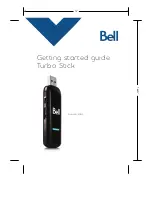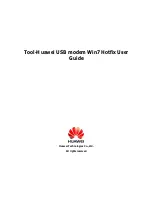
External Modem User's Manual
32
includes part of the number, and all but the last command line end with the "
;
" followed by a carriage
return.
^ Tone
Control
Toggles calling tone enable/disable:applicable to current dial attempt only.
P
Pulse Dialing
P
, placed ahead of a number, tells the modem to dial a number using pulse dialing.
S
Dial a Stored Number
S
is used to dial one of four numbers stored in nonvolatile memory. For example, instead of entering a dial string,
you can use this command:
Command:
ATDS=1<CR>
T
Touchtone Dialing
T
, placed ahead of a number, tells the modem to dial a number using touchtone dialing.
W
Wait for Dialtone
W
, placed after a number, tells the modem to wait up to 30 seconds to detect a one-second
continuous dialtone before dialing the next number.
W
is most often used in a PBX system to wait for
the dialtone of an outside telephone line.
5.3 Commands Not Preceded By AT
Two commands, A/ and +++, are neither preceded by the attention code
AT
nor followed by a carriage
return.
A/
Repeat Command
A/
repeats the execution of the last command line stored in the command buffer. If the last command
line is invalid, the ERROR result code will appear on the screen. Note that
A/
cannot be preceded by
AT
; if it is, ERROR will appear on the screen.
+++
Escape
+++ followed by AT <CR> allows the modem to escape from the data mode to the on-line command state
(command state without breaking the established connection.)
To escape, stop transmitting data, wait at least one escape guard time (the default time is one second), and then
enter three consecutive escape characters (the default character is +) followed by AT <CR>.
The modem will return to the command state and send the
OK
result code to the screen. Note that the escape
command is the only command that can be recognized by the modem in the one-line state; it cannot be
recognized in the command state.
















































